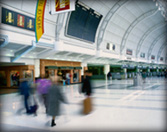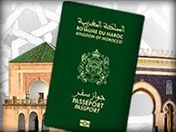Quick access
Security and Customs
Security
Submit yourself willingly to security controls: It is in your own interest!
These controls are performed before access to the boarding area. Hand baggage must pass through a radioscopic control device and may, also, be subject to hand search.
If you have a bunch of keys or other metal object, place it on the carpet of the radioscopic control device. This will avoid triggering an audible alarm when you pass through the detection gate.
Due to strengthening security measures in aviation, you must now do the same for any object (metal or otherwise) that you carry with you (watch, bracelet, necklace, etc.) as well as your jackets or coats.
For small objects, a small basket is made available to you. These objects or clothing will be given back to you after your passage through the gantry.
However, it should be noted that it is strictly prohibited to place in your hand luggage blunt or sharp objects such as penknives, scissors, knives, cutters, weapons or objects that can be considered a weapon, etc.
Any object of this type, will be removed by security control and may be destroyed without your being compensated.
If you wear a pacemaker or any implanted technical device (insulin pumps, and even some hearing devices) inform the security officer and do not go through the gantry - But you will not on this account be dispensed of body search -.
You should also know that, from extra precaution, you may be asked to proceed at the foot of the plane, to the identification of your checked baggage.
Finally, never leave your luggage unattended in the premises of the terminal.
Guidelines for the classification of prohibited items
These guidelines concern the different forms that may have the restricted weapons and items.
Nevertheless, it is common sense that determines, if necessary, to consider whether an object can be used as a weapon.
- Firearms:Any weapon allowing to fire a projectile under the effect of an explosion or the action of compressed air or gas, including starter pistols and flare guns.
- Knives and cutting tools : Sabers, swords, cardboard cutters, hunting knives, utensils for martial arts, professional tools and other knives with a blade length greater than / or equal to 6 cm and knives considered illegal under local law.
- Blunt Instruments: Blackjacks, billy clubs, baseball bats or similar instruments.
- Explosives/ Munitions / Flammable liquids / Corrosive products: Any explosive or incendiary which alone or in combination with other items can cause an explosion or fire. This category includes explosives, detonators, pyrotechnic products, gasoline, other flammable liquids, ammunition or any combination of these items. Any corrosive or toxic substances including gaz- tablets or not-
- Neutralizing or Disabling Articles: tear gas, incapacitate and other chemicals or similar gases contained in pistol, canister, or other container and other neutralizing items such as electronic appliances having a paralyzing or neutralizing effect by electric discharge.
- Other items such as ice picks : The alpenstocks, razors, sharp scissors, which are generally not considered deadly or dangerous weapons but can nevertheless be used as a weapon, as well as the weapons or grenades toys or dummy.
- Articles of all sorts that could reasonably make believe that it is a deadly weapon. These items include objects resembling explosive articles or other items that can pass for a weapon or dangerous objects. These examples are not exclusive.
- Articles, chemical and biological substances thatcan be used inattacks. The possibility of chemical and biological attacks include the use of chemical or biological agents to commit unlawful acts. These regulated chemicals or biological substances include: The hyperite sulfur, VX gas, chlorine, sarin, the hydrogen cyanide, anthrax, botulism, smallpox, tularemia, and viral hemorrhagic fever (VHF).
- Items that have the character of chemical or biological substances or suspected to present such substances are immediately reported to the airport authorities, the police, the military authorities or other competent authorities and are isolated from the Airport areas that are accessible to the public.
Security measures for liquids, aerosols and gels (LAGs)
- As of November 15th, 2013, restrictions on the transport of LAGs on aircrafts were implemented. These restrictions are:
- All LAGs must be carried in containers with a maximum capacity of 100 (ml).
- Containers must be placed in a transparent sealable plastic bag with a maximum capacity of one liter and must be easily placed in this bag which must be sealed.
- The LAGs carried in containers larger than 100 ml will not be accepted at the PIF, even if the container is only partly filled. The vacuum container superior to 100 ml capacity is authorized.
- Exemptions to the above rules are granted to LAGs if:
- The LAGs are intended to be used during the trip and are necessary for medical purposes or to meet special dietary needs or baby food. Security officers may ask the passenger, if they deem it necessary, the exempted liquid authenticity proof.
- The LAGs were purchased from a store located in Airport restricted security area; provided in a security tamper-evident bag and that there is satisfactory evidence that the product was purchased in the airport in less than 24 hours time.
- The LAGs come from another domestic airport, upon the condition that they are put in a security tamper-evident bag and that there is satisfactory evidence that the bag was purchased in the airport during the same day.
- The LAGs were purchased from one of the national air company aircrafts, provided they are contained in a security tamper-evident bag provided by the air company and that there is satisfactory evidence that the bag was purchased from the aircraft during the same day.




